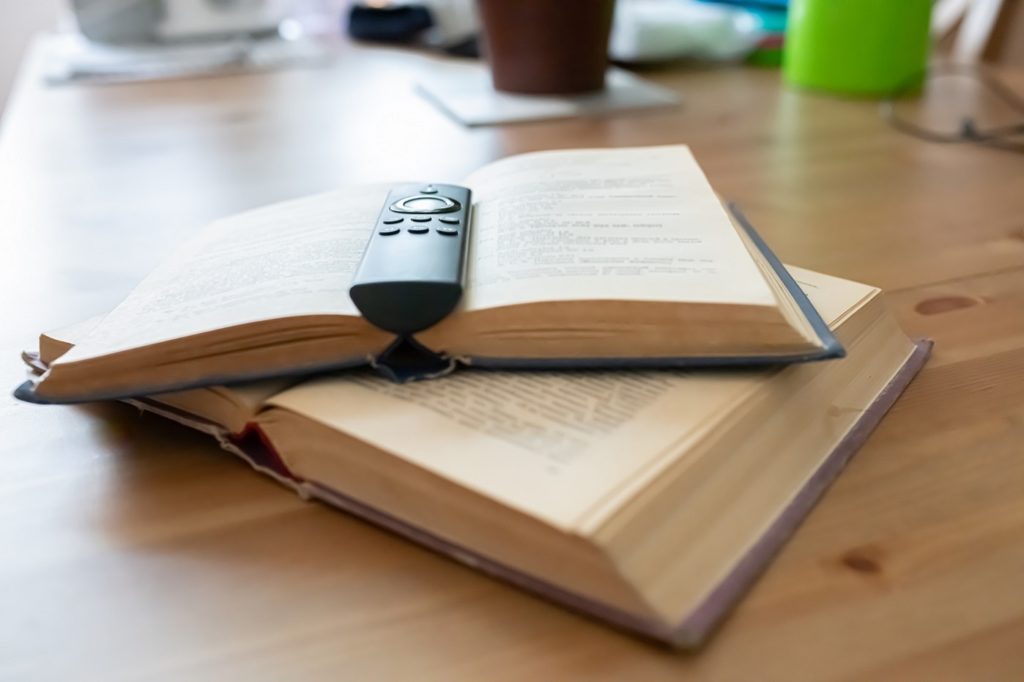A couple of weeks ago, the literary scholar Karen Swallow Prior posted a six-panel cartoon on Twitter, titled “Six Things You’ll Never Hear from an English Major.” The fifth panel had someone saying to a friend in a cinema, “The movie was better than the book.” My reply was that this has often been rightly said, “since many first-rate movies have been made from third-rate books.”
The exchange put me in mind of a pet theory of mine that the greatest novels are unfilmable, whereas many of the greatest films have been based on novels that one might call “merely good.” Over the years I have tried to test the proposition by reading the novels on which some notable movies were based, and to think through why my theory might be true—if it is. I think it holds up, for the most part.
Start with some material that has never translated well to the screen. Mark Twain’s The Adventures of Huckleberry Finn, often acclaimed as one of the greatest American novels, has never been adapted into a passable film, even when the talent of young Mickey Rooney was brought to bear on it in 1939. Flaubert’s Madame Bovary, despite the talent of Vincente Minnelli directing Jennifer Jones in the title role in 1949, was not a very successful treatment of that novel’s depths.
Or take such a seeming natural for the silver screen as Dumas’s The Three Musketeers. With its swashbuckling adventurers, action, and romance, the story has still never been retold really well in a movie. (Richard Lester’s two-film adaptation in the 1970s was such a farrago of foolish slapstick and vulgar stuntwork that I don’t even want to link to it.) And every admirer of Tolkien’s The Lord of the Rings, even those who also like Peter Jackson’s films, would agree that the mythic nobility of the novels is not achieved on the screen. What accounts for consistent failures like these?
Start your day with Public Discourse
Sign up and get our daily essays sent straight to your inbox.I think it is a question of interiority. On the printed page, characters like Huck Finn, Emma Bovary, D’Artagnan, and Frodo undergo real changes in their characters. For good or ill, they lose their innocence. But we can only glimpse these evolutions fully through the prose narration of their interior struggles; it is exceedingly difficult to write such struggles for the screen, let alone to act them. What’s more, the rollicking humor of Finn, the pathos of Bovary, the occasional winking bawdiness of the Musketeers, and the battles in Middle Earth become broad to the point of a distasteful flatness in their film adaptations, so much so that they flatten the emotional and moral power one experiences in reading the books.
Cinema thrives, one is almost sorry to say, on thinner material. A good adaptation can even take such liberties as to improve markedly on a book in many cases. Consider John Ford’s 1941 film of Richard Llewellyn’s elegiac novel of late nineteenth-century Wales, How Green Was My Valley. By a drastic truncation of the novel that confined the movie’s action to the childhood of the narrator, Philip Dunne’s screenplay brought a nearly 500-page novel within the scope of a two-hour film, and captured the essence of Llewellyn’s tale after the fashion of a jeweler cutting a rough diamond into symmetrical perfection.
Likewise Walter Van Tilburg Clark’s The Ox-Bow Incident, which already reads as very filmable, was improved by distillation into William A. Wellman’s nearly perfect 76-minute Western. And A. E. W. Mason’s adventure in the Sudan, The Four Feathers, was stripped for action in the Korda brothers’ 1939 film, whereas the more recent version made by Shekar Kapur in 2002 was inferior precisely in those respects in which it was truer to Mason’s rather ponderous novel.
Sometimes it is not subtraction but addition that helps a movie rise above its source material. Piers Paul Read, in his biography of Sir Alec Guinness, reports that when Pierre Boulle’s The Bridge over the River Kwai was undergoing adaptation for David Lean’s 1957 film (including a change of its preposition to on the River Kwai), the studio wanted an American film star to be featured to appeal to U.S. audiences. Hence the minor character of Major Shears, originally a British member of the commando team sent to blow up the bridge, was transformed into a larger American character by the same name, played by William Holden, who has escaped from the same P.O.W. camp whose British inmates, commanded by Guinness’s Colonel Nicholson, are building the bridge.
This crass commercial decision turned out to be the making of a vast improvement on a book whose structure is, by comparison, as shaky as Colonel Saito’s first bridge. For the character in the movie of the cynical, reluctantly heroic Shears is a bridge of another kind, one that connects the separate stories of the camp and the commando raid, making the final scene’s fatal confrontation between Shears and Nicholson a fitting denouement to the tragedy. This connective tissue is wholly absent in Boulle’s novel, which is weaker for it.
Finally, there is the rare novel that is itself written so cinematically that reading it is almost the same experience as seeing the film. This was how I felt when reading Charles Portis’s True Grit, after seeing the 1969 Henry Hathaway film starring John Wayne as the one-eyed deputy marshal Rooster Cogburn. Written in the first-person voice of Mattie Ross, the novel is vivid with descriptions of places, persons, and actions, and stuffed with plentiful dialogue. There is little interiority in Mattie’s tale, which is almost all motion—and that made filming it so natural.
The makers of the 1969 film omitted the novel’s coda, which briefly summarized the aftermath of the main action, taking the tale all the way to Cogburn’s death years later. The 2011 remake by the Coen brothers included this material, but the original film was stronger for its omission—and in my (probably minority) opinion, stronger in casting every part, but especially Wayne’s casting as the old marshal. Both film versions, however, benefit from the brisk straightforwardness of the book, whose narrative structure and distinctive dialogue are evident throughout both movies.
I could adduce many other examples of good-but-not-great novels that were creatively adapted into excellent movies, but I trust readers see my point. Many of the books behind our favorite films are very much worth reading. But the medium of cinema does not necessarily translate great literature effectively. We may have to get used to there being no good movies of our favorite novels—to the book always being better, if our favorites are high art. But great art on film—better than its source material—can indeed be made out of books of a more middling sort.














